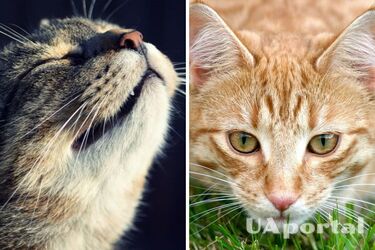Scientists have found that cats have an excellent sense of smell due to "mazes" in their noses

When it comes to exceptional sense of smell, dogs often come out on top. But, as a new study has revealed, cats also have a highly developed sense of smell, and scientists are trying to uncover its secrets.
The researchers created a computer model of the cat's nose using CT scans and tissue samples from a deceased domestic cat that was donated for research purposes. When a cat sniffs, the airflow is divided into two different pathways for breathing and smelling.
Read also: Do cats understand human language?
The model was used to show that the animal's nasal passages direct the flow of odors through a complex network of channels called nasal concha. This structure, the scientists suggest, can function as a gas chromatograph, a sophisticated chemical device that separates compounds based on their solubility. Odors that do not dissolve well in nasal mucus spread further and bind to more distant odor receptors.
"We know that animals, including cats, use their sense of smell to detect food, sense danger, and recognize relatives," says Kai Zhao, a bioengineer in the Department of Otolaryngology at The Ohio State University and co-author of the study.
The spiral structure discovered by the researchers is more than 100 times more efficient than the straight channel found in the noses of amphibians and some mammals, and can accommodate more odor receptors in the limited space of the head. The study was published on Thursday in the journal PLOS Computational Biology and was partially funded by Mars Petcare UK, a pet food company.
"They show that the structure of the nasal concha in cats is very complex compared to other mammalian species," says Luis Saraiwa, an olfactory neuroscientist at Sidra Medicine in Qatar who was not involved in the study. And what's most striking is that "cats have many more nasal concha than rats or humans."
This is not the first time that the gas chromatograph analogy has been used to explain nasal anatomy. The idea was proposed as early as the 1960s, but most of the studies investigating this were conducted on amphibians, which have a simpler nasal structure. Previous studies have shown that other animals with an exceptional sense of smell, such as dogs, rats, and bobcats, also have a twisted nose with nasal concha. However, this new paper is the first to examine the anatomy of the domestic cat's nose and extends the gas chromatograph analogy to mammals.
The sensitivity of the sense of smell in cats may also explain why they react to unpleasant odors by making a characteristic face. According to Saraiwa, similar to humans who smell rancid milk, cats may be trying to close their nasal passages to avoid deep inhalation of this odor.
"The next big step will be to try to combine these computational studies with physiological studies in real animals," says Tom Aiting, a physiologist at Burrell College of Osteopathic Medicine who has studied the sense of smell in bats and was not involved in this study.
According to him, the researchers hope to reveal the solubility of different odors in the context of the location of specific odor receptors in the nose of cats.
"The complex structure of the nose in animals emphasizes how advanced their sense of smell is. However, we should not expect that cats will soon replace dogs as explosives detectors. It's very difficult to train cats," Zhao said.
Earlier, we wrote about what dogs think when they bow their heads.
If you want to get the latest news about the war and events in Ukraine, subscribe to our Telegram channel!
